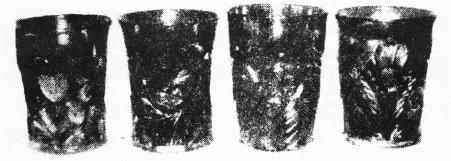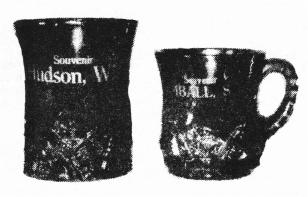Carnival Glass Tumblers by Cambridge
by John &
Lucille Britt
Issue No. 122 - June 1983
EDITOR'S NOTE: The following article was taken from the Carnival Glass newsletter.
The Cambridge Glass Company made much more carnival glass than it
was once thought a few years back. If you had a piece of everything
they made, you indeed would have a fabulous and beautiful collection.
 I
will discuss here only the five Cambridge patterns that were made in
carnival glass tumblers. Cambridge also made some beautiful tumblers in
colored pressed glass and in ruby stained pattern glass.
I
will discuss here only the five Cambridge patterns that were made in
carnival glass tumblers. Cambridge also made some beautiful tumblers in
colored pressed glass and in ruby stained pattern glass.
Many of the Cambridge pieces, but not all, are marked with the "NEAR CUT" mark. This "NEAR CUT" signature is found on the inside and on the base of the tumblers. But again, not all of their tumblers are so marked. It is interesting to note that the Cambridge patterns are all of the so called "inverted" or "near cut" designs. This not only applies to the tumbler patterns featured here, but to all the other carnival glass patterns that were made by Cambridge, of which I am aware.
DOUBLE STAR - I will start with the one that is the easiest to find. This pattern is sometimes called Buzz Saw, but to the tumbler or water pitcher collector it is generally known as "Double Star". The green "Double Star" tumbler is by far the most common of the Cambridge carnival glass tumblers. It is interesting to note that the tumblers are not signed in this pattern, or at least I have never seen one with the "Near Cut" mark. Some of the water pitchers are signed, however, and I have also seen some without the mark. The marigold "Double Star" tumbler is a different story, as it is quite scarce and indeed rather hard to find. I would class the purple tumbler as being very rare. It has been my experience that only occasionally do you ever see this one in the purple color. The accompanying photograph shows "Double Star" in all three colors. My purpose of showing this picture is to show you both sides of this tumbler. Note the opposite side, which is shown on the center tumbler in the photograph.
INVERTED STRAWBERRY - In this patter the amethyst or purple is the most common tumbler, if indeed you can call any of them common. This is a very desirable pattern and I have seen them in four colors including cobalt blue. In this pattern all of the tumblers I have seen carry the "Near Cut" mark. I have seen only a few of these in marigold and even less in green. The blue is very rare. The complete water set in any color is a prized possession. The only sour note to this otherwise magnificent tumbler is that it has been reproduced. A little study on your part, however, should make it rather easy to tell the difference. First, the new ones have that new look and are of a heavier feel when you handle them. The old tumblers definitely feel lighter when you handle them. Another distinctive difference, and in my opinion an important one, is that the leaves and strawberries on the new tumblers have the letter "B" on the outside of the tumbler just above the base and along the bottom of the tumbler. This "B" is not very distinct, however, and sometimes it is quite hard to find. You will also find some of the new ones signed "Terry Crider" on the bottom of the base. Hanson also signed some of the inverted strawberry tumblers. Some also have the "B" in the base instead of the "Near Cut" mark. The "B" is the mark for Bennett. The latter three are not confusing at all and offer no problem whatsoever. On all of the new "Inverted Strawberry" tumblers, just remember that they have that new carnival look, they are and feel quite a bit heavier; and that the leaves and berries are much deeper cut or pressed into the tumbler. If you will remember these factors, you should not be fooled by the new tumblers on the market today. Some say that the "Near Cut" mark is neater and more distinct on the old ones. I would probably agree with this, but they are so much alike that I would not recommend this method of telling the difference, especially if you are a new collector.
INVERTED THISTLE - LATE THISTLE - This is a very fine pattern. The water pitcher and tumblers are both quite rare. This is one of Lucile's favorite tumblers in our collection. Here is one of those cases where the marigold tumbler is much harder to find than the purple one. The purple one doesn't come up for sale very often either, so if you have a purple one it is also a "goody". I have never seen this tumbler in green, even though other pieces of this pattern such as bowls are known to exist in green. It is possible that a green tumbler might show up in this pattern some day. I have seen some of these tumblers that were marked, although most of them do carry the "Near Cut" mark in the base. The Inverted Thistle tumbler rates high on everyone's list. It is not only rare, but it is also a beautiful and most desirable tumbler. Many tumbler collections are missing this pretty tumbler. The pitcher is very rare and would rate in the top twenty water pitchers in carnival glass collections.
INVERTED FEATHER - This is the most rare of the Cambridge pattern tumblers. It is known in green and amberish marigold. A purple tumbler has not been reported in this pattern, even though it is possible that a few might exist. Most pieces in this pattern are very rare. The most common pieces are the little marigold sort of flared out parfait type stemmed glass and the green cracker jar. I have seen and know of only one water pitcher. It is interesting to note that the "Near Cut" mark is on the handle of this pitcher. The few tumblers I have seen, and that would be only 10 or 12, do not have the "Near Cut" mark. This is indeed a most desirable and rare tumbler and would surely rank in the top ten in most everybody's carnival glass tumbler list.
This tumbler is often confused with the Millersburg "Feather and Heart" tumbler. I have talked with a number of collectors that call the "Feather and Heart" the "Inverted Feather" tumbler. Both tumblers do carry the feather like motif, and also there are hob stars on both tumblers. The "Inverted Feather" is the third from the left in the accompanying photograph. Note that there are no hearts whatsoever on this tumbler. On the "Feather and Heart" tumbler there is a band of four hearts that are upside down along and around the bottom of the tumbler. The feathers are at the top of the tumbler whereas on the "Inverted Feather" the feathers are at the bottom of the tumbler.
 NEAR CUT SOUVENIR - The photo at left shows the "Near Cut Souvenir" in
both the tumbler and the mug. These pieces were souvenir pieces and
usually carry the name of the city in the United States or Canada such
as Pierre, SD. The tumbler does not have the "Near Cut" mark, as does
the mug. This tumbler is not easy to come by and is quite desirable.
The marigold color is rich and beautiful, and the iridescence is
exceptionally nice on both the inside and out. I have never seen a
water pitcher to match the tumblers to this pattern. Collecting this
tumbler with different cities engraved n them could be quite
interesting.
NEAR CUT SOUVENIR - The photo at left shows the "Near Cut Souvenir" in
both the tumbler and the mug. These pieces were souvenir pieces and
usually carry the name of the city in the United States or Canada such
as Pierre, SD. The tumbler does not have the "Near Cut" mark, as does
the mug. This tumbler is not easy to come by and is quite desirable.
The marigold color is rich and beautiful, and the iridescence is
exceptionally nice on both the inside and out. I have never seen a
water pitcher to match the tumblers to this pattern. Collecting this
tumbler with different cities engraved n them could be quite
interesting.
If you are interested in other carnival glass pieces and patterns that were made by Cambridge, I recommend that you read the article written by Jack Adams in the June issue of the Carnival Pump newsletter of the I. C. G. A. This is a fine article and has a complete listing of carnival Cambridge patterns. Jack and Mary Adams have done considerable research work on Cambridge Glass and it was through their efforts that old advertising data was found to designate such patterns as "Venetian" and "Sweetheart", once thought by some to be Millersburg, to definitely be Cambridge patterns.
